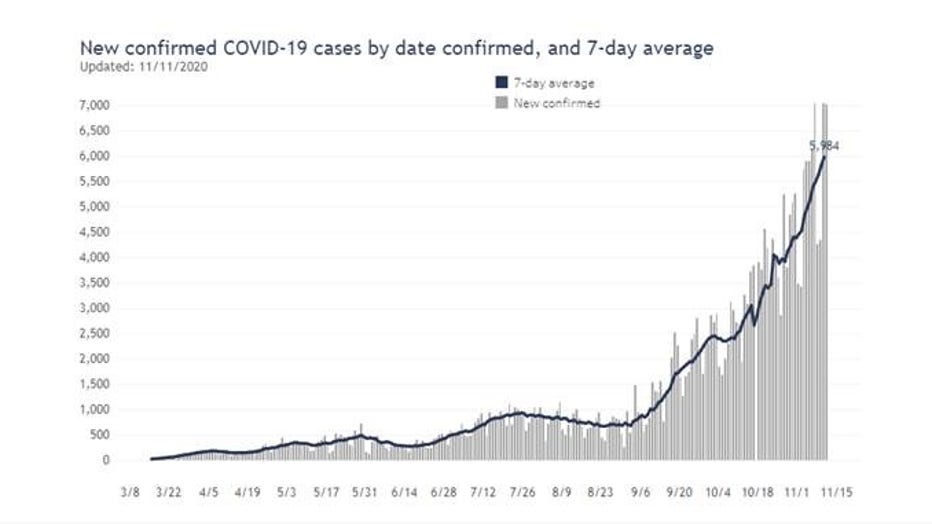By the numbers: Wisconsin's exponential 2-month COVID-19 surge

People hold signs during a protest against the coronavirus shutdown in front of State Capitol in Madison, Wisconsin, on April 24, 2020. (Photo by KAMIL KRZACZYNSKI/AFP via Getty Images)
(FOX 9) - COVID-19 numbers in the state of Wisconsin have exponentially increased statewide over the last two months, culminating in three of the last five days producing more than 7,000 new cases and dozens of deaths.
The state says 285,891 total case have been reported to date and the state is close to 2,500 total deaths. Here is how some of the key COVID-19 metrics have changed over the last two months during the surge.
Cases
Wednesday's 7,049 new COVID-19 cases is the third highest single-day increase of the pandemic. Nov. 7 was the second highest increase with 7,065 new cases and Nov. 10 is the standing single-day record of 7,073 new cases.

A case spike in the state of Wisconsin on this graph produced by the Wisconsin Department of Health Services. (Wisconsin Department of Health Services)
The 7-day case increase average, what officials say is a key metric in analyzing cases, has grown exponentially in the state since this date two months ago.
- Nov. 11 - 5,984 - 7-day case increase average
- Oct. 11 - 2,510
- Sept. 11 - 985
All three of those dates marked a record high 7-day case increase average.
Deaths
Wednesday was tied for the third highest single-day death increase of the pandemic with 62 new deaths reported. Similar to cases, the 7-day death increase average is an important statistic for analyzing the lethality of the virus over time.
- Nov. 11 - 43 - 7-day case increase average
- Oct. 11 - 13
- Sept. 11 - 6
Percent positivity
The percent of all COVID-19 tests that return positive is a metric that can predict COVID-19 spikes. This week, the state has set daily records as more than one in three tests in the state are coming back positive.
- Nov. 11 - 35.9 percent - 7-day average percent positive rate
- Oct. 11 - 19.4 percent
- Sept. 11 - 13.8 percent
The pandemic so far
COVID-19 infections can often go undetected and be asymptomatic; laboratory-confirmed tests only represent a fraction of actual COVID-19 cases. A study from the Journal of the American Medical Association estimated that actual cases in some instances were six to 24 times greater than reported cases.
Wisconsin Gov. Tony Evers announced an indoor mask mandate for people over the age of 5, which he extended until November 21. Face coverings while indoors except at a private residence have been required since Aug. 1.
Evers extended the state's stay-at-home order until May 26, but on May 13, the state Supreme Court blocked the extension, effectively opening all establishments in the state. Hours later, images emerged of packed bars across the state, leading the Governor to call his state "The Wild West." Evers' original "Safer at Home" order went into effect on March 25. In October, a judge did however allow Evers' mask mandate to remain in effect.
On April 4, President Donald Trump approved a disaster declaration for Wisconsin due to the COVID-19 pandemic. This declaration allows for federal funding to be allocated to state, tribal and eligible local governments and certain private nonprofit organizations that were impacted by the virus.
For more information, go to the state health department's website.

Tips on washing your hands to reduce spreading germs
Amid the coronavirus outbreak, health officials are advising people to be sure to wash your hands. Follow these tips to help reduce the spread.
If you have questions or immediate needs related to COVID-19, you can Text COVID19 to 211-211, visit 211Wisconsin.org or call 211. Call volumes are high, so officials are asking people to be patient and try to use the text or online options first.
If you are experiencing signs and symptoms of COVID-19, health officials advise you to call your health care provider.

